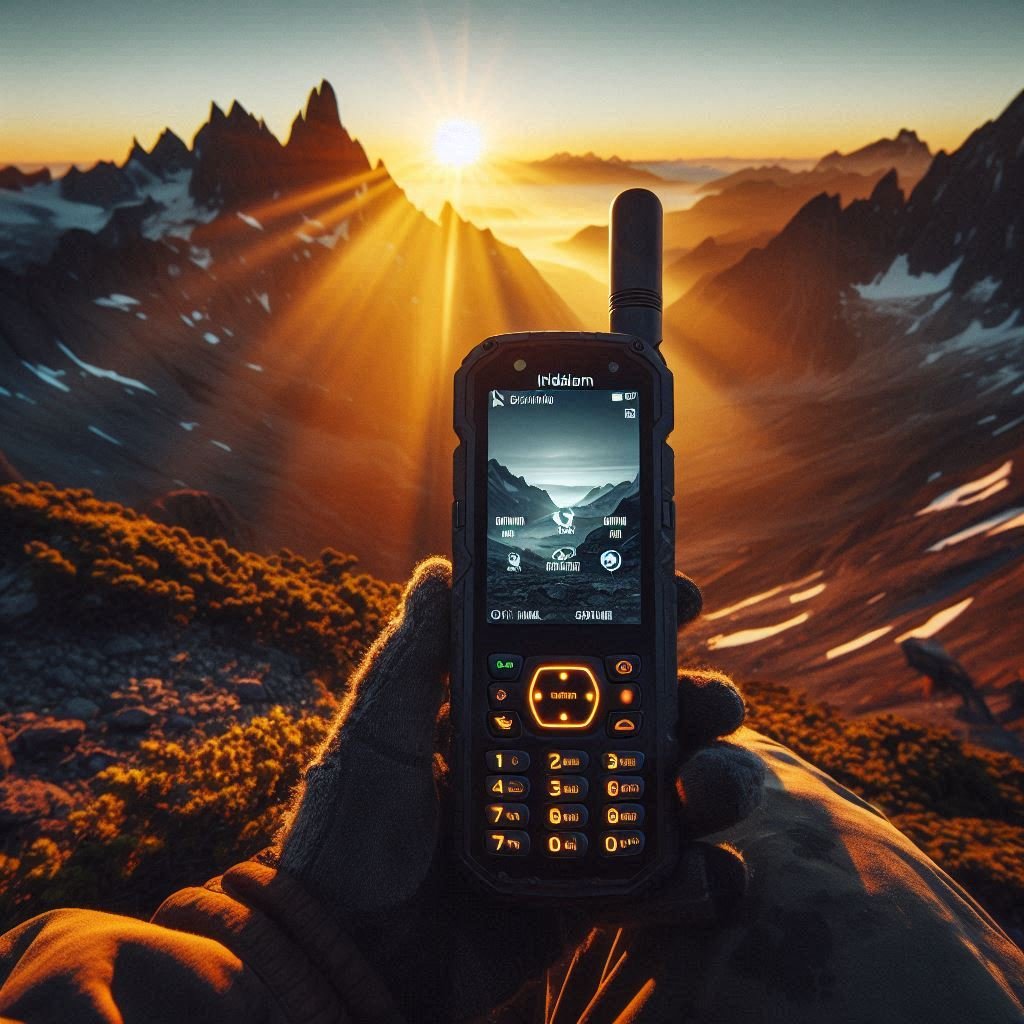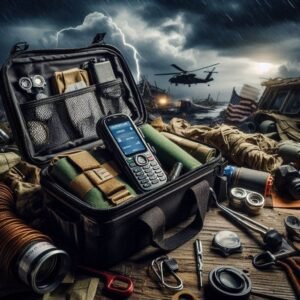Iridium Satellite Phones: The Ultimate Guide to Global Connectivity for Adventurers, Professionals & Emergency Preparedness
In our always-connected world, there’s a paradox many adventurers and professionals face: the further you venture from civilization, the more crucial communication becomes.
As we navigate through 2025, Iridium satellite phones continue to reign supreme as the gold standard for those who need unwavering connectivity in the planet’s most remote corners.
While most of us take for granted the ability to call, text, or browse the internet with a quick tap on our smartphones, there are vast stretches of our world where conventional cell networks simply don’t reach.
Enter the world of satellite communication – where the sky itself becomes your network provider.
Understanding Satellite Communication in 2025
Before diving into specific devices, let’s understand what sets satellite communication apart.
Unlike traditional cellular networks that depend on ground-based towers with limited range, satellite phones connect directly to orbiting satellites circling the Earth.
This fundamental difference explains why a hiker stranded in a remote canyon or a sailor navigating the southern ocean can still call for help when conventional phones show “No Service.”
Among the various satellite networks available, Iridium’s robust satellite network stands out with its unique architecture and unparalleled reliability.
Why Iridium Dominates the Satellite Phone Market
1. True Global Coverage Without Exceptions
The cornerstone of Iridium’s superiority is its network design. Operating a constellation of 66 cross-linked low-earth orbit (LEO) satellites that orbit just 485 miles above Earth’s surface, Iridium has achieved something remarkable: true pole-to-pole coverage of our entire planet.
Unlike competitors who have coverage gaps over polar regions or certain oceanic areas, Iridium’s satellites work in harmony to create a seamless web of connectivity spanning every mountain, desert, ocean, and ice cap on Earth.
For explorers venturing to Antarctica or sailors crossing the Pacific, this difference isn’t just a convenience—it can be lifesaving.
2. Battle-Tested Reliability in Extreme Conditions
When your communication device might be your lifeline, durability becomes non-negotiable. Modern Iridium satellite phones like the Iridium 9575 Extreme and the trusted Iridium 9555 are engineered specifically for the punishment of extreme environments:
- Military-grade durability with IP65 or better ratings (waterproof, dustproof, and shock-resistant)
- Arctic-to-desert temperature tolerance functioning in conditions from -10°C to +55°C
- Extended battery performance with up to 30 hours on standby and 4+ hours of talk time
- Integrated emergency features including dedicated SOS buttons on premium models
- User-replaceable antennas for field repairs when professional service isn’t an option
These aren’t devices designed for occasional camping trips—they’re communication tools built for professionals who stake their lives on reliable connectivity.
3. Increasingly Accessible Pricing Models
The perception that satellite communication is prohibitively expensive is increasingly outdated.
While still representing a significant investment compared to cellular service, Iridium’s flexible prepaid and monthly plans have made satellite connectivity more accessible than ever.
In 2025, basic voice and SMS plans start at $54.99/month with various prepaid options available for occasional users.
For those requiring data connectivity, affordable packages supporting email and light browsing are readily available, though users should temper expectations regarding speed compared to terrestrial networks.
4. Expanding Ecosystem Beyond Traditional Phones
Perhaps the most exciting development in the satellite communication landscape is the proliferation of satellite messengers and emergency communicators powered by Iridium’s infrastructure.
These devices have democratized access to satellite technology by offering lower entry points for users who need emergency connectivity but not necessarily voice calling.
Leading examples include:
- Garmin inReach series providing two-way text messaging, location sharing, and SOS capabilities
- RockSTAR by Beam Communications transforming your existing devices into satellite-connected tools
- Iridium Certus terminals delivering broadband connectivity for maritime vessels, aircraft, and remote operations
- Iridium GO! creating personal hotspots for smartphone integration with satellite networks
This diversity of hardware means users can select precisely the level of connectivity they need without overpaying for unnecessary features.
Cost Breakdown: Investing in Satellite Communication
Understanding the true cost of satellite communication requires looking beyond the initial sticker price:
Hardware Investment
- Traditional Satellite Phones: $800–$1,500 for current generation devices
- Satellite Messengers: $200–$600 for messaging-focused devices like the inReach
- Professional Systems: $3,000+ for maritime, aviation, or enterprise installations
Service Plans (2025 Pricing)
- Basic Voice & SMS: $55–$80/month with limited included minutes
- Standard Usage: $80–$150/month for regular users (10-20 minutes daily)
- Data-Enabled Plans: $100–$200/month for email and light browsing capabilities
- Prepaid Options: Typically starting at $40 for 30 days with pay-per-minute billing
Hidden Considerations
- Activation Fees: Often $50–$100 for initial setup
- Equipment Insurance: Highly recommended given the investment
- Battery Replacements: Factor in backup batteries for extended expeditions
While these costs exceed conventional cell service, the perspective shifts when you consider what you’re truly purchasing isn’t just communication, but potentially life insurance for remote activities.

Comparing the Major Satellite Networks in 2025
The satellite communication landscape features several major players, each with distinct advantages:
Iridium Network
- Coverage: Complete global coverage including polar regions
- Reliability: Exceptional in all weather conditions
- Specialization: Voice calls, SOS functionality, and reliable two-way messaging
- Best For: Extreme expeditions, professional use, and life-critical applications
Starlink
- Coverage: Expanding but still optimized for fixed locations
- Reliability: Excellent for broadband but requires larger equipment
- Specialization: High-speed internet, video conferencing, and data-intensive applications
- Best For: Remote living, large vessels, and base camps needing internet connectivity
Globalstar (SPOT Devices)
- Coverage: Good continental coverage with significant oceanic gaps
- Reliability: Variable depending on location
- Specialization: Affordable one-way messaging and basic tracking
- Best For: Recreational hikers and budget-conscious users in supported regions
Inmarsat
- Coverage: Global except for polar regions
- Reliability: Very good in supported areas and value-priced
- Specialization: Maritime and aviation communications
- Best For: Commercial shipping, yachting, backcountry use and business applications
For those requiring true global reliability without exceptions, Iridium remains the undisputed leader, particularly for handheld devices and personal emergency communication.
Real-World Applications: Who Depends on Iridium?
The diversity of Iridium users reflects the versatility of the technology:
Adventure Seekers
From solo hikers traversing the Pacific Crest Trail to sailing teams circumnavigating the globe, adventurers rely on Iridium for both safety and staying connected with supporters.
The ability to send daily updates, receive weather forecasts, and summon help if needed has transformed how people approach remote adventures.
Emergency Response Teams
When disasters strike and terrestrial networks fail, satellite communication becomes the backbone of coordination efforts.
Search and rescue teams, disaster relief organizations, and medical evacuation services all depend on Iridium’s reliability when responding to earthquakes, hurricanes, and other catastrophes where conventional infrastructure is compromised.
Remote Professionals
For those whose work takes them far from cellular coverage, Iridium provides essential connectivity:
- Scientific researchers conducting fieldwork in remote locations
- Oil and gas professionals working on offshore platforms
- Journalists reporting from conflict zones or disaster areas
- Wildlife conservationists monitoring endangered species in wilderness areas
Maritime and Aviation Sectors
Beyond coastal waters and established flight paths, Iridium provides critical communication links for:
- Commercial fishing vessels operating in distant waters
- Private aircraft traversing oceanic routes
- Cargo ships maintaining operational connectivity worldwide
- Expedition cruises venturing into polar regions
Emergency Preparedness Enthusiasts
As natural disasters become more frequent and severe, a growing community of preparedness-minded individuals are incorporating satellite communication into their emergency kits.
When regional disasters knock out cell towers for days or weeks, an Iridium phone represents insurance against communication blackouts.
Satellite Messengers: The Gateway to Satellite Communication
For many users, the full functionality of a dedicated satellite phone exceeds their needs and budget.
Enter satellite messengers – compact devices that leverage Iridium’s network for essential communication without the cost of voice capabilities.
The Garmin inReach series has emerged as the category leader, offering:
- Two-way text messaging to any cell phone or email address
- Interactive SOS with 24/7 monitoring and response coordination
- Detailed weather forecasts on demand
- GPS tracking and location sharing
- Basic navigation capabilities
These devices, typically ranging from $300-500 with service plans starting around $15/month, have democratized access to satellite communication technology, making it accessible to weekend warriors and casual adventurers.
Practical Considerations: Using Satellite Phones Effectively
Owning a satellite phone requires understanding some fundamental differences from conventional cell phones:
Line-of-Sight Requirements
Unlike cell phones that can work indoors, satellite phones require a clear view of the sky. Dense forest canopies, steep canyons, and buildings can all obstruct the signal.
Users must factor in their surroundings when planning communication.
Weather Impacts
Heavy rain, thunderstorms, and extreme weather can sometimes degrade signal quality, though Iridium’s LEO satellites are less affected than geostationary alternatives.
Power Management
Battery conservation becomes critical in remote settings. Experienced users develop disciplines like scheduled check-ins rather than leaving devices powered continuously.
Cost-Conscious Usage
With per-minute rates still significantly higher than cellular calls, developing efficient communication habits (like pre-planning conversation points) can substantially reduce costs.
Testing Before Departure
Perhaps the most important practice is thoroughly testing equipment before venturing into remote areas, ensuring familiarity with operation and confirming functionality.
Can Your Phone Connect to Satellites for Emergencies? Here’s What You Need to Know
Satellite connectivity on smartphones is becoming more common, but right now, your options are limited.
If you need emergency satellite features, you’ll need one of these devices:
- iPhone 14 or newer (including iPhone 15 and 16)
- Samsung Galaxy S25
- Google Pixel 9 series
Most Android phones don’t yet support satellite connectivity, though that may change in the future.
If you have a compatible device, you can enable emergency SOS features to send messages via satellite when you’re off the grid.
Apple’s Emergency SOS via Satellite
Apple was the first to bring satellite communication to smartphones with the iPhone 14 in 2022.
Here’s how it works:
- Compatible Devices: iPhone 14, iPhone 15, and iPhone 16 series.
- Availability: Originally launched in the U.S., Canada, UK, and parts of Europe, but has since expanded to Australia, New Zealand, and several other countries.
- How It Works: If you’re outside cellular coverage, your iPhone can connect to satellites to send emergency texts with your location. You’ll need a clear view of the sky for it to work.
- Cost: Free for the first two years—Apple hasn’t announced pricing after that.
One limitation: It’s a one-way service, meaning you can send messages but not receive replies. Still, it’s been a lifesaving feature for many since its launch.
Google Pixel 9’s Satellite SOS
Google’s Pixel 9 series introduced Satellite SOS, powered by Samsung’s Exynos 5400 modem. Key details:
- Lets you message emergency services via satellite when there’s no cell signal.
- Works with Verizon’s emergency SOS as an alternative option.
- Free for two years, then likely requiring a subscription.
Samsung Galaxy S25’s Satellite Features
Samsung’s latest flagship is the first to support Snapdragon Satellite, Qualcomm’s satellite messaging solution.
- Requires the Snapdragon X80 modem (found in the Galaxy S25’s chipset).
- Also supports Verizon’s emergency SOS service.
Right now, the Galaxy S25 is the only phone with this feature—even other phones with the same modem don’t have access yet.
The Bottom Line on Smartphone Satellite Features
If you need satellite connectivity for emergencies, your best bet is an iPhone 14 or newer, a Pixel 9, or a Galaxy S25.
Most other phones—even recent Android flagships—don’t support it yet, but that could change as more carriers and manufacturers roll out solutions.
These smartphone solutions provide valuable emergency options but remain fundamentally different from dedicated Iridium devices in both capability and reliability.
The smartphone features are designed for occasional emergency use, while Iridium phones are purpose-built for consistent communication in remote environments.
The Future of Satellite Communication
As we navigate through 2025, several trends are reshaping satellite communication:
Integration with Conventional Devices
The line between satellite and cellular is blurring, with major smartphone manufacturers exploring more advanced satellite connectivity beyond basic emergency messaging.
However, these consumer implementations remain limited compared to dedicated Iridium devices, with full two-way communication still exclusive to purpose-built satellite phones.
Improved Data Capabilities
While voice communication remains the primary function, data speeds are gradually improving, making email, weather updates, and basic internet more practical through satellite connections.
Smaller, Lighter Hardware
Miniaturization continues to reduce the size and weight of satellite communication equipment, with some newer models approaching the dimensions of larger smartphones.
Lower Service Costs
Increased competition and growing user bases are gradually driving service costs down, though satellite communication will likely always command a premium over terrestrial alternatives.
Making Your Decision: Is an Iridium Phone Right for You?
When considering whether to invest in an Iridium satellite phone or satellite messenger, ask yourself:
- How frequently will I be beyond reliable cell coverage?
- What would be the consequences of being unable to communicate in an emergency?
- Do I need voice capabilities, or would messaging suffice?
- What is my budget for both equipment and ongoing service?
- Am I prepared to learn and adapt to the unique requirements of satellite technology?
For those who regularly venture beyond the reach of cellular networks—whether for work, adventure, or emergency preparedness—the question often shifts from “Can I afford a satellite phone?” to “Can I afford not to have one?”
Where to Purchase Iridium Equipment
To ensure you receive genuine equipment with proper warranties and activation support, purchase only through authorized channels:
- Satellite Phone Store – Offering comprehensive packages and expert consultation for purchase and rentals
- Beam Communications – Specializing in both consumer and professional solutions
- Garmin Store on Amazon (for inReach devices) – Providing integrated GPS and satellite messaging solutions
- Authorized Iridium Service Providers – Listed on Iridium’s official website
Avoid the temptation of second-hand equipment, as satellite devices may have activation restrictions or undisclosed issues that compromise reliability.
Connectivity Beyond Boundaries
In a world increasingly dependent on constant communication, there’s profound reassurance in knowing that technology exists to keep us connected even in Earth’s most remote corners.
Iridium satellite phones and the broader ecosystem of satellite communication tools represent more than just impressive technology—they embody freedom to explore, security during crises, and connections that truly know no boundaries.
Whether you’re scaling unclimbed peaks, sailing distant oceans, working in challenging environments, or simply preparing for uncertainties, Iridium’s network stands ready to ensure your voice can always reach those who need to hear it.
Stay connected—no matter where life takes you. Your next adventure awaits, and with the right tools, you’re never truly alone, even in the world’s most isolated places.
Have you had experience using satellite communication in remote locations? What challenges did you face?
Share your stories in the comments below!
- Global Coverage: No Roaming Charges – Make and receive voice calls, SMS, track your position with GPS from anywhere on t…
- Complete Kit: Includes Inmarsat IsatPhone 2.1 satellite phone handset, Lithium-ion battery, International AC wall charge…
- Durable Design: Withstands dirt, dust and jets of water from every direction; IK04 shock resistance rating and an ingres…






